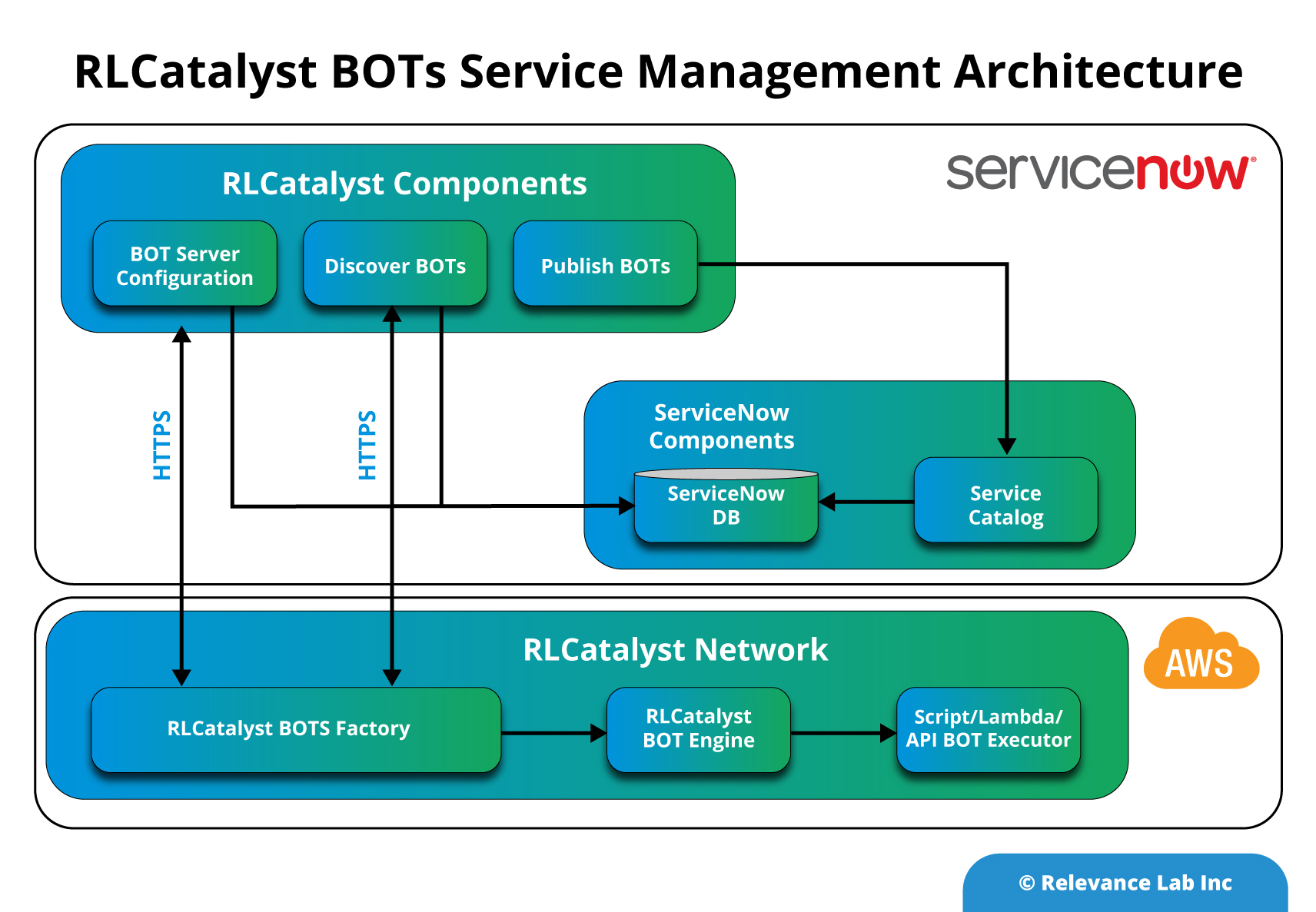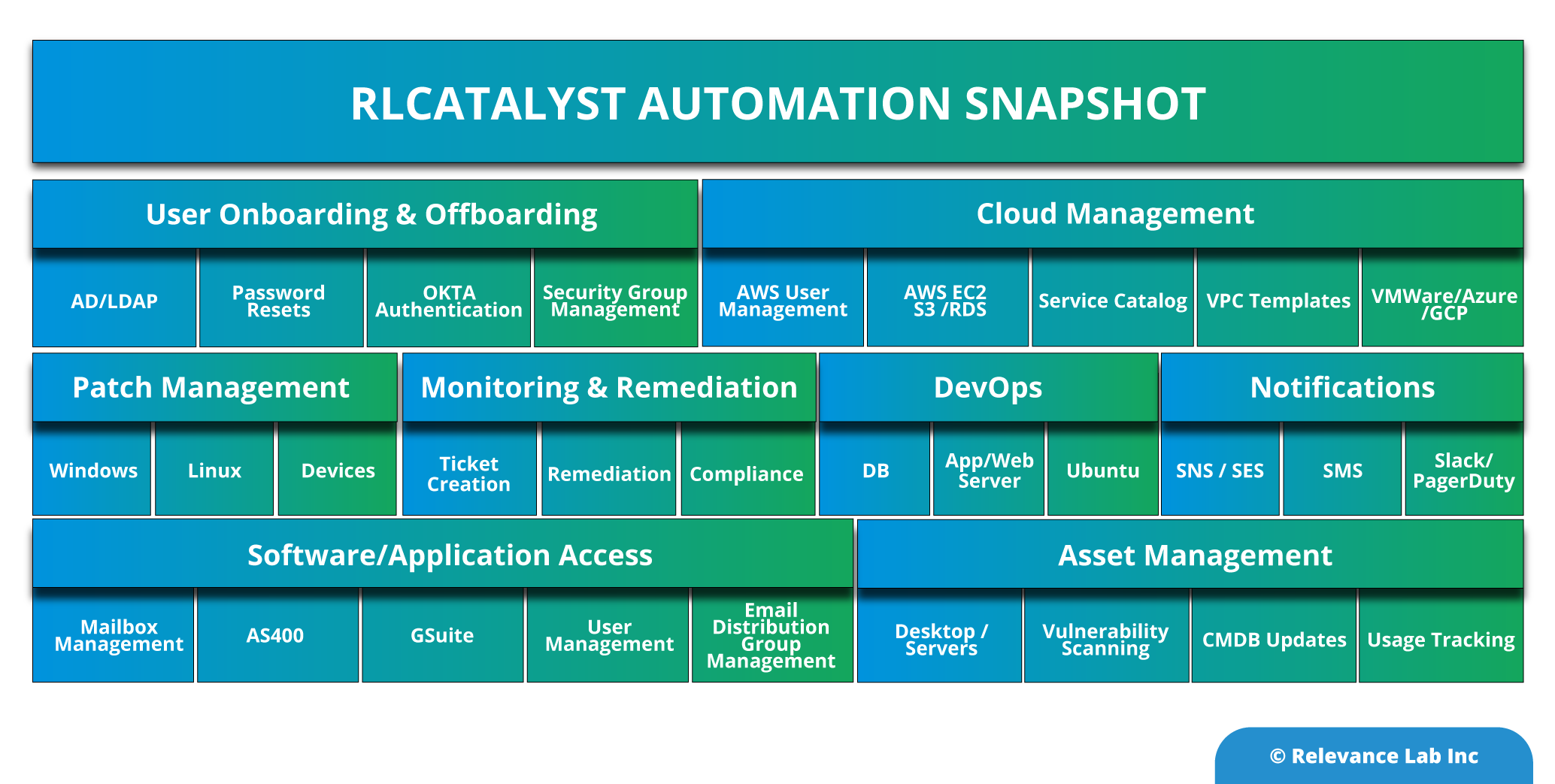2020 Blog, Blog, Featured, RLCatalyst Blog, ServiceNow
RLCatalyst BOTs Service Management connector for ServiceNow
Relevance Lab in partnership with ServiceNow and AWS has launched a new solution (ServiceNow scoped application) to consume Intelligent Automation BOTs from within ServiceNow self-service Portal with 1-Click automation of assets and service requests using the Information Technology Service Management (ITSM) governance framework. This RLCatalyst BOTs Service Management (RLCatalyst BSM) connector is available for private preview and will very soon be also available on ServiceNow Marketplace. It integrates with ServiceNow self-service Portal and Service Catalog to dynamically publish an enterprise library of BOTs for achieving end to end automation across infrastructure, applications, service delivery and Workflows. This solution builds on the concept of “Automation Service Bus” architecture explained in a blog earlier.
The biggest benefit of this solution is a transition to a “touchless” model for automation within ServiceNow Self Service Portal with a dynamic sync of enterprise automation libraries. It provides an ability to add new automation without a need to build custom forms or workflows inside ServiceNow. This makes creation, publishing and lifecycle management of BOTs automation within the existing governance models of ITSM and Cloud frictionless leading to faster rollout and ROI. Customers adopting this solution can optimize ServiceNow and Cloud operations costs significantly with self-service models. A typical large enterprise Service Desk team gets a huge volume of inbound tickets on a daily basis and more than 50% of these can be re-routed to self-service requests with a proper design of service catalog, automation and user training. With every ticket fulfilment cost (normally US $5-7) now handled by BOTs there is a significant and measurable ROI along with faster fulfilment, better user experience and system based compliance that helps in audits.
Following are the key highlights of this solution
- Rendering of RLCatalyst BOTs under ServiceNow Service Catalog for 1-Click order and automation with built in workflow approval models.
- Ability of ServiceNow Self Service users to order any Automated Service Request from this standard catalog covering common workflows like.
- Password Reset Requests.
- User Onboarding.
- User Offboarding.
- AD/SSO/IDAM integration.
- Access and Control for apps, tools, and data.
- G-Suite/O365/Exchange Workflows.
- Installation of new software.
- Any standard service request made available by enterprise IT in a standard catalog.
- Security and approvals integrated with existing ServiceNow and AD user profiles.
- Ability to involve any BOT from the RLCatalyst BOTs server that provides integration to agent base, agent-less, Lambda function, scripts, API based, UI based automation functionality.
- A pre-built library of 100+ BOTs provided as out-of-the-box solution.
As a complementary solution to AWS Service Management connector customers can achieve complete automation for their Asset and Service Requests with Secure Governance. For assets being consumed on non AWS footprints like VMWare, Azure, On-prem systems, the solution supports automation with Terraform templates to address hybrid-cloud platforms.
What are BOTs?
Any Automation functionality dealing with common DevOps, TechOps, ServiceOps, SecurityOps and BusinessOps. BOTs follow an Intelligent Automation maturity model as explained in this blog earlier.
- BOTs Intelligent Maturity Model
- Task Automation.
- Process Automation.
- Decisioning Driven Automation.
- AI/ML Based Automation.
BOTs vs Traditional Automation
- BOTs are reusable – separation of Data and Logic.
- BOTs support multiple models – AWS Lambda Functions, Scripts, Agent/Agentless, UIBOTs etc with better coverage.
- BOTs are managed in a Code repository with Config Management (Git Repo) – this allows the changes to be “Managed” vs “Unmanaged scripts”.
- BOTs are wrapped in YAML Definitions and exposed as Service APIs – this allows BOTs to be involved from Third-Party Apps (like ServiceNow).
- BOTs are “Managed & Supervised Runs” – BOT Orchestrator manages the lifecycle to bring in Security, Compliance, Error Handling and Insights.
- BOTs have a Lifecycle for Intelligent Maturity.
- Open Source Platform that can be extended and integrated with existing tools on a journey to achieve AIOps Maturity.
- Very deeply embedded with ServiceNow and leverages data and transaction integration in a bi-directional way.
The following image explains the RLCatalyst BOTs Service Management Architecture.

How does RLCatalyst BOTs Service Management work?
Integrating your ServiceNow instance with RLCatalyst BOTs Server helps you to publish self-service driven automation to your ServiceNow Service Portal without the need for custom coding or form design. Your users can order items from the Service Catalog which are then fulfilled by BOTs while maintaining record of the transactions in ServiceNow via Service Requests.
The ServiceNow administrator first downloads the scoped application and installs it in her ServiceNow instance. The application can be deployed from the Github repository provided by Relevance Lab. In the near future, this application will also be available from the ServiceNow Application Store.
Once installed, the application is configured by the ServiceNow Administrator. The person will fill the “BOTs Server Configuration” form. The required parameters are BOTs Server URL, Server Name, Is Default, Username and Password. This information is stored in the ServiceNow instance and is then used to discover and publish BOTs from the RLCatalyst BOTs Server.
The application administrator clicks on the Discover BOTs screen to retrieve the list of latest BOTs available on the BOTs Server. Once this list is displayed, the administrator can choose the BOTs person wants to publish and select the kind of workflow person wants to associate with that BOT (none, single or multi-level approvals). Then person clicks on the Publish button on doing which the BOTs are published to the Service Portal along with all the Forms associated with the BOT for input.
End-users can then use the self-service Catalog items to request fulfilment by BOTs.
What is the standard library of RLCatalyst BOTs available with this solution?
RLCatalyst provides a library of 100+ BOTs for common Service Management tickets and can help achieve up to 30-50% automation with out-of-the-box functionality across multiple functionalities as explained in diagram below.
- User Onboarding and Offboarding.
- Cloud Management.
- DevOps.
- Notification Services.
- Asset Management.
- Software and Applications Access Management.
- Monitoring and Remediation.
- Infrastructure Provisioning with integration to AWS Service Catalog.

Summary of Solution benefits
The RLCatalyst BOTs Service Management connector is providing an enterprise wide automation solution integrating ServiceNow to Hybrid Cloud assets with an ability to have self-service models. The automation of Asset and Service requests provides significant productivity gains for enterprises and in our own experience has resulted in achieving 10 FTE productivity, 70% automation of inbound requests and more than US $500K of annual savings on operations costs (including reduced headcount), ITSM license costs, Cloud assets optimized usage with compliance and 50% efficiency gains on internal IT Workflows.
Following are some key blogs with details of solutions addressed with this RLCatalyst BSM connector.
- Intelligent Automation for User and Workspace Onboarding
- AWS Research Workbench with Intelligent Automation using ServiceNow
- Frictionless and Secure Automation with RLCatalyst and OKTA
- Intelligent Automation for SOX Compliance
For more details, please feel free to reach out to marketing@relevancelab.com
